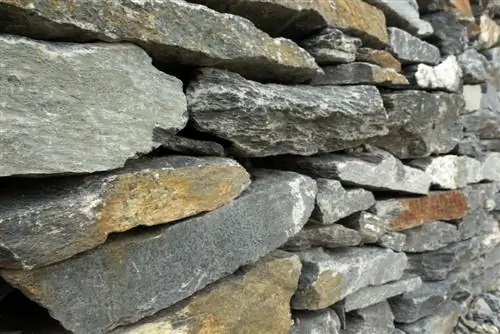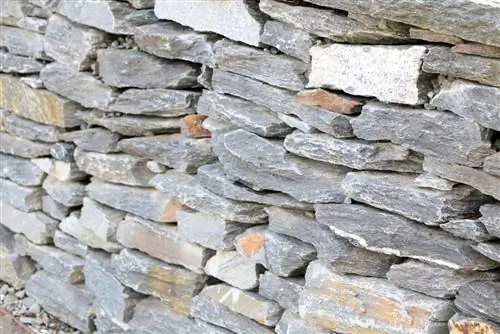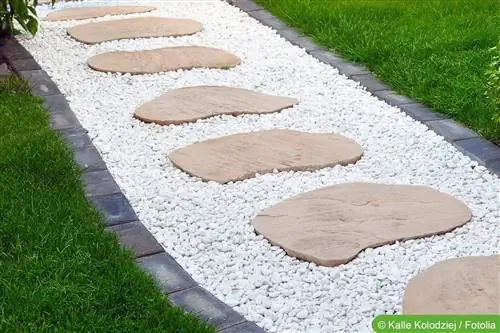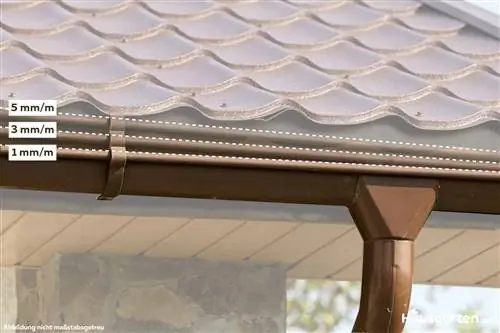- Author admin [email protected].
- Public 2023-12-17 03:39.
- Last modified 2025-01-24 12:45.
Slope reinforcement is a must in many gardens. Whenever there is a slope or embankment in the garden that cannot be removed or can only be removed with great effort, sooner or later the question of protection against slipping arises. There are a few ways to do this. But the classic is undoubtedly the massive stone retaining wall.
Retaining wall
The best way to secure a slope, hill or embankment safely and reliably is to build a retaining wall including a foundation. It offers the best conditions for being able to withstand very high pressure. What is particularly important is that it is anchored in the ground on a foundation. This construction means that the wall is much less likely to be pushed down by the earth. A retaining wall is usually built from conventional natural stones. However, it is more practical to use so-called planting stones, which, as the name suggests, can be planted and thereby bring even more green into the garden.
In general:
The greater the mass of the earth and the steeper the slope, the more massive the wall must be.
Retaining wall made of plant stones
Planting stones are building elements that are cast from concrete. They have a cavity into which soil can be easily filled. Plant stones are available commercially in ring form or as rectangular boxes. Depending on the manufacturer, they have toothed elements on the sides with which they can be connected to one another.
Tip:
When buying plant stones, make sure that they can be interlocked on the sides. This provides additional stability and usually saves annoying bricklaying work.
Plant stones are also available in different colors and design variations. However, their big advantage is that they can be individually adapted to the basic course of the slope or embankment. They are also much easier to process. Since building a retaining wall itself involves a lot of work, you should do everything you can to avoid making the whole thing unnecessarily difficult. In any case, planting stones make building walls much easier.
Instructions
Constructing a retaining wall out of plant stones is admittedly complex, but in principle it can also be carried out by laypeople. Above all, however, a professional should be called in for work on the foundation and for setting the wall base in concrete in order to avoid possible errors in this very sensitive area. In order for the project to be successful reliably, good planning is required. This planning also includes taking the so-called slope water into account. This is meltwater or rainwater that flows down the slope. It must be intercepted and drained behind the wall using drainage. Without drainage, there is a risk that water pressure or frost in winter will damage the retaining wall sooner or later. Before you start the actual construction work, drainage must first be created.
Create foundation
A retaining wall is only truly stable if it rests on a solid foundation. To create a foundation, a trench must first be dug along the slope. A distance of around 50 centimeters from the slope is recommended. The following must be taken into account:
- Trench depth 60 to 80 centimeters
- Fill the trench from below with a frost-proof gravel and gravel mixture
- Filling height: 30 to 50 centimeters
- Pour concrete up to a thickness of 30 centimeters

The concrete foundation should be about five centimeters wider on both sides than the plant stones that will be placed on it later. In addition, space must be left behind the foundation for drainage. This is best done by laying drainage pipes. The pipes should rest on a layer of gravel to protect them from frost.
Setting plant stones
Once the concrete of the foundation has hardened, you can begin to place the planting stones. The first row of stones is placed on a layer of mortar to firmly connect them to the foundation. The free space between the stones and the slope is filled with gravel. It must be thoroughly compacted, otherwise the protective function could suffer. The stones themselves can also be filled with gravel or a mixture of gravel and sand. Alternatively, you can use potting soil here. Once the mortar on which the first row of stones sits has dried out, the further rows can be placed. It is important to always place them offset towards the slope. The stones in all other rows are also filled. The number of rows depends of course on the planned height of the wall - and this in turn on the size of the slope.
Note:
The plant stones must be exactly horizontal. It is therefore advisable to check their position every now and then with a spirit level and adjust if necessary.
Planting
One of the advantages of planting stones for securing slopes is that they can be planted. Plants that are relatively undemanding are particularly suitable for this. It is also recommended to cover the soil in the stone with a layer of gravel or mulch to protect it. Planting makes it possible to create visual accents in the garden. The retaining wall is not only very functional, but also an eye-catcher.
Alternatives
If you are afraid of the high level of effort involved in building a retaining wall and, above all, in laying a foundation, you can resort to various alternatives. These can generally be used to fix a slope. However, none of them offer the level of protection that can be achieved with a solid retaining wall. However, they are definitely useful for stabilizing hills, embankments and other height differences in the garden.
Gabions
Gabions work in a similar way to a wall when it comes to fortifying slopes. In a sense, they represent a kind of barrier that is intended to stop the soil from slipping. In order for this to actually work, they must have a high level of stability. Heavy stones inside the gabion's mesh cage ensure that they can only be moved with considerable effort.

A stabilizing foundation, however, is completely missing and is usually not necessary. The big advantage of gabions is certainly that they can be removed relatively easily if necessary.
Wooden palisade
A wooden palisade made of round beams driven into the ground ultimately also fulfills a wall function. It gains stability because a certain part of each individual beam is stuck in the ground. Wooden palisades for securing slopes certainly have a special visual appeal. However, they are not permanently weatherproof and will have to be replaced sooner or later.
Drywall
A dry stone wall is a wall in which the stones are not fixed with mortar, but are simply stacked on top of each other and wedged into one another. Natural stones are usually used for this.

L-stones
L stones get their name because they are shaped like the letter “L”. They can also be used to build a retaining wall to fortify a slope. The shorter side of the cast stone lies on the ground, the longer side lies at the foot of the slope. The stones are not anchored separately.
Terracing
Basically, a slope or embankment can also be stabilized by installing artificial terraces. However, this usually also means that higher surfaces need additional support. In addition, the terracing is extremely complex.
Planting
One of the most common causes of a landslide is erosion. A slope or embankment should therefore always be planted in order to protect the soil underneath. The roots of the plants in particular fulfill an important function. The following applies: Deep-rooted plants are better suited than less deep-rooted ones. The deep anchoring of the root system in the earth stabilizes the surface and thus prevents slipping to a certain extent.
Embankment mats
Slope mats, usually made of coconut, are actually only suitable for quickly securing a freshly filled embankment. They are placed on the ground over a large area before planting before the embankment is planted. Their special structure then ensures that plants find better support. The mat can also help hold the surface together, at least for a while.
Security
The danger that can arise from a landslide should definitely not be underestimated. Depending on the situation, this can result in enormous damage to property and a lot of hassle. Stabilizing a slope is therefore not a luxury, but rather a smart precautionary measure. Under certain circumstances, it can even be made a requirement by the municipality or the state building insurance company. Speaking of the municipality: Anyone planning to build a retaining wall should ask their municipality or city administration in advance whether they need a building permit and, if in doubt, obtain one.






